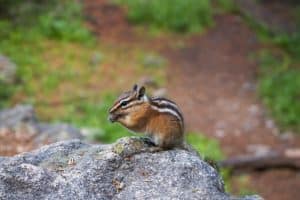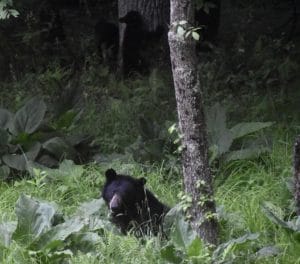Hello fellow readers, I hope you enjoy the story of Jolee’s big dig, inspiring a chat about chipmunk remedies and legends about why they have stripes.

Photo by James Lee on Unsplash
“It’s the only way I could get her to stop digging.”
Three weeks ago, after working in the field, I came home to two Adirondack chairs straddling the rock garden. “It’s the only way I could get her to stop digging,” Curt explained as he jumped off the riding mower. Jolee by his side.
Clearly, she took advantage of eyeballs off and busily uprooted the plants in pursuit of chipmunks—her hole about four feet wide and a foot deep.
“Where does the soil go?” Curt asked.
Jolee’s dig likely caused the chipmunk condominium to cave in. I wondered where the plant parts went, but didn’t ask, knowing Curt tidied up the scene before placing the chairs.
Chipmunks have a stealth way of building their abodes.
As chipmunks build their 20 to 30-foot multi-tunnel abodes, they stuff the dirt into their cheeks and deposit it elsewhere, hence no mounds at their entry hole. How stealth. This same cheek stuffing strategy is how they carry their stash of seeds, bulbs, tender roots, and root vegetables into their homes to dine on through the winter.
Penn State University says there are often two to four chipmunks per acre, though as many as ten per acre can hunker down if there’s enough food and cover. My rock wall may be the capital of the neighborhood, as there seem to be armies scurrying around. Worrisome as they can cause structural damage. They live about three years, breed twice a year, and have two to five young who then have their own young’ uns within a year. You do the math.

Photo by Ann DeCamp
Chipmunk remedies
You can find organic topical sprays, such as Critter Ridder, made from black pepper and chili pepper. But chipmunks tunnel to eat roots, so topical sprays don’t work very well, though the critters with a yen for spicy food may enjoy the feast.
There are snap traps, poisonous bait, and live traps to relocate them. But who will be the lucky recipient of your transport? Plus, chipmunks will likely return after moving them unless they are more than ten miles away.
Years ago, my design colleague and dear friend, Marty Carson, suggested Juicy Fruit gum. It has to be the old-fashioned stick kind in the yellow wrapper, not easy to find. I unwrapped the sticks using gloves to keep them free of human scent and tossed them in their holes.

Photo by Alex Lauzon on Unsplash
Chipmunks seem to like Juicy Fruit Gum.
The theory is that they eat the gum, which buggers up their innards. Not very humane, I know. But neither is eating roots causing plants to suffocate, poor dears. The punchline is my chipmunks like juicy fruit gum, and it seems they invited their friends to join the party. Maybe they’ll croak from rotting teeth.
Marty suggested an outdoor cat for sure to do the trick—that, or a rescue dog from the streets of Biloxi, Mississippi—proud Momma.
Of all the techniques, a quarter-cup of castor oil (the original stinky kind) mixed with a gallon of warm water and a couple of drops of dish detergent to saturate the ground near the holes sounds like the most promising way to evict them. They hate the smell and bitter taste. Work your way out so as not to encourage them to hunker down near your foundation.
The chipmunk party has lessened since the big dig.
Yes, the rock wall party of chipmunks seems to have lessened since the big dig. I waited a few weeks, with chairs still poised, to be sure our huntress lost interest in the site. Then filled the gap with composted soil and planted a temporary solution of an assortment of marigolds. Mary’s Gold, I called them as a kid. After learning the Legend of Marigolds a few years back, I grew to admire them again. I’m hoping the roots remain of the plants once there, and they’ll magically return. But not the chippers. Nothing personal.
 An Iroquois legend of a bear and a chipmunk
An Iroquois legend of a bear and a chipmunk
In preparing this story for the newspaper, I looked for legends about chipmunks and found an Iroquois legend of a bear and a chipmunk. There are many versions; one, in brief, goes like this.
A bear touts his power and strength as he turns over a log to reveal a chipmunk under it. The chipmunk exclaims that if you are so strong, make the sun not rise tomorrow morning. He assures the chipper that he is powerful enough to do that.
The bear was unable to achieve his stated strength.
The following day, when the sun rose, the chipmunk raced around in glee, touting and making fun of the bear for being unable to achieve his stated strength. The bear grew angry and pinned the chipmunk to the ground, demonstrating his power and threatening to kill the little critter.
The chipmunk begged for one more prayer, but he needed more breath if only the bear could release the pressure on him a bit. He did, and of course, the chipmunk scurried back into his abode.
What gave chipmunks stripes
As a legend goes, the bear took one swoop of a chipmunk on its back and left the three stripes that exist today. The lesson is not to bully. As the story is told, it was in the light of the chipmunk bullying the bear. But wasn’t it a two-way street?
I imagine it’s a story the Iroquois shared as a lesson to their children. Perhaps it’s a lesson adults can learn, too. Think about the bullying in our government and among politicians, teaching our youth that it’s okay.
Digging a bit further, I read on the First People of America and Canada website, “To this day, all chipmunks wear scars as a reminder of what happens when one animal makes fun of another.”
Imagine if there weren’t any scars or stripes.
Garden Dilemmas? AskMaryStone@gmail.com (and on your favorite Podcast App.)
You’ll enjoy more of the story in Episode 66 of the Garden Dilemmas Podcast.
Link to complete story about the Chipmunk and a Bear, an Iroquois Legend
Link to the story about The Legend of Marigolds




any casteroil based spray for moles scares away chipmunks too. It is nonviolent, cheap and organic
Thank you, Gary! Nonviolent, cheap, and organic checks all the boxes. I appreciate the tip. Thanks for reading my post, Mary Stone
We have a 50 foot boulder wall off of our patio and only about 10 feet from the back side of our cabin. Our wall is home to at least 8-10 chipmunks. They run everywhere and put on quite a show for us when we take our meals next to our big kitchen window. They are fun to watch but full of mischief. I am constantly trying to save my plants and keep my lawn from looking like a mine field. My wife feeds everything that wanders by so every bird and every furry creature in the forest stops by. Our security lights go on and off all night long. The party continues in our neck of the woods, in Kentucky.
Hi Tony, I can visualize the scene of your party in your descriptive words, and am chuckling as I write. Better to laugh than cry. Ha! Thank you for reading my post and sharing your story — and for adoring all the critters we share the Garden of Life with, Mary Stone